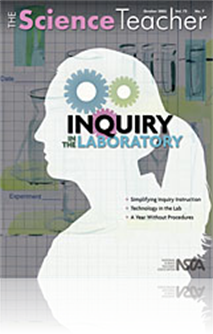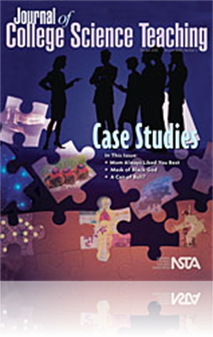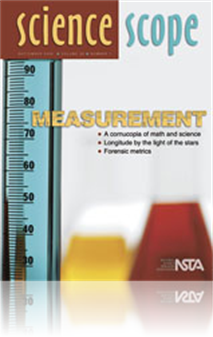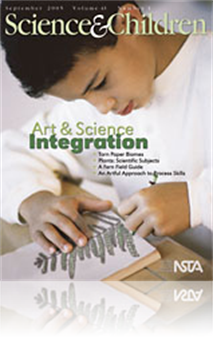All Resources
Journal Article
Commentary: Needing a New Approach to Science Labs
A recent report conducted by a National Research Council (NRC) committee found that science labs have the potential to help students master science subject matter, develop scientific reasoning skills, increase interest in science, and achieve other i...
Journal Article
The authors of "How Far are the Stars," featured in the February issue of The Science Teacher, showed how the measurement of parallax permits scientists to infer astronomic distances. Give your students the chance to make similar inferences through a...
Journal Article
A Can of Bull? Do Energy Drinks Really Provide a Source of Energy?
This case study involves the biochemical analysis of the components of commonly available energy drinks, which many students purchase at fairly high prices. Students research the ingredients in each product and their physiological role in the human b...
Journal Article
Simplifying Inquiry Instruction
Inquiry instruction is a hallmark of the current science education reform efforts. However, defining inquiry and assessing how much inquiry is supported by a particular activity or lab can be difficult and confusing. This article presents a simplifie...
Journal Article
Tried and True: The living periodic table
To help make the abstract world of chemistry more concrete to your middle-school students, have them create a living periodic table that can be displayed in the classroom or hallway. This display includes information about the elements arranged in th...
Journal Article
Laboratory Instruction in the Service of Science Teaching and Learning
The Benchmarks for Science Literacy and the National Science Education Standards strongly suggest that students should be engaged in hands-on learning. However, too frequently the school laboratory is far removed from the recommendations of construct...
Journal Article
A Strange Fish Indeed: The "Discovery" of a Living Fossil
Through a series of fictionalized diary entries, this case recounts the “discovery” in South Africa in 1938 of a fish believed to be extinct for over 70 million years. Developed for use in a freshman biology course as an introduction to the natur...
Journal Article
Using an Artificial Rock Outcrop to Teach Geology
The lack of rock outcrops is a national problem that impacts how students learn geology all over the United States. To compensate for this problem, try using the suggestions described in this article to construct an artificial rock outcrop that provi...
Journal Article
Editorial: The Interrupted Case Method
There are many ways to tell a tale. This issue of the journal demonstrates that point as it devotes itself once again entirely to case studies. One particularly useful type of case study is the Interrupted Case Method. In this form, information is...
Journal Article
Why should teachers emphasize the nature of science? Not only does it help students to think and solve problems like scientists, but students will learn how knowledge is developed in science. In this section, the editor discusses the nature of scie...
Journal Article
The concept of flight for human beings has always been closely tied to imagination. To fly like a bird requires a mind that also soars. Therefore, good teachers who want to teach the scientific principles of flight recognize that it is helpful to sha...
Journal Article
Technology in the Lab: Part Two
Probeware is increasingly being implemented in science classrooms because it is less expensive than it used to be and improvements in hardware and software have made it more accessible to students and teachers. This article focuses on probeware activ...
Journal Article
Geoscientists Explore the Earth
Visit the American Geological Institute (AGI) Earth Science Week website to learn about how you can provide your students with inquiry-based learning experiences that celebrates the theme, "Geoscientists Explore the Earth." On the website you will fi...
Journal Article
Science 101: How do we know protons, electrons, and quarks really exist?
Scientific explanations often make use of things we cannot see or feel, such as protons, electrons, and quarks. Do these really exist? If so, how do we know they exist?...
Journal Article
Cancel the Cardinals Home Opener?! Lessons in Melting and Evaporation
The St. Louis Cardinals are scheduled to play their home opener the next day and Megan Riley, a young meteorologist who works for a private weather consulting firm, is responsible for developing the weather forecast. It’s looking like she may need ...
Journal Article
A teacher’s most effective strategy for creating a safe lab environment is to train students to follow recommended safety procedures. Students who understand the reasons for the safety rules and the dangers of breaking the rules can assume responsi...
Journal Article
Teacher's toolkit: Measurement stations
This issue of Science Scope debuts Teacher's Toolkit, a new column featuring an array of tips, strategies, and resources for teachers addressing instructional issues in science. Over the course of the school year, the column will feature how-to sugge...
Journal Article
Never Too Young for a Concept Map
This article provides ideas on how concept mapping can be adapted to reach early childhood learners when organizing their thoughts in a concrete and/or graphic/visual format, while connecting concepts and linking prior knowledge to new knowledge....
Journal Article
Creating torn paper biomes integrates science and visual art in a performance task that assesses students' knowledge of the characteristics of the biomes of the earth. Students who have difficulty communicating their knowledge in writing can show wha...
Journal Article
Science instructors sometimes avoid inquiry-based activities due to limited classroom time. Inquiry takes time, as students choose problems, design experiments, obtain materials, conduct investigations, gather data, communicate results, and discuss t...
Journal Article
"Say when." That expression, usually reserved as an inquiry by a solicitous dispenser of party libations, is apt for the serious case writer. In both cases it is meant to find out how much is enough. How much liquid or information should we dole ou...
Journal Article
A Message from the NSTA President: Developing a World View for Science Education
In this section, NSTA President Michael Padilla shares a story reflecting the affect that immigration has had on almost all school systems across the country. He shares his motivation for choosing Developing a World View for Science Education as the...
Journal Article
Satellite Remote Sensing of Coral Reefs
Coral reefs are one of the most endangered ecosystems as coral reef coverage has declined dramatically in the past three decades. In recent years, satellite remote sensing has become a popular and effective mapping tool for ecological studies, especi...
Journal Article
Self-efficacy is a key predictor of achievement and retention in most academic areas, including the sciences. In this study, the effects of teaching strategies on self-efficacy and course climate were examined. Question and answer, collaborative lear...
Journal Article
Point of View: Evolution and Friendship
According to the National Center for Science Education (2001), forty-four states have faced challenges to the teaching of evolution, in venues ranging from local school boards to state legislatures. The saddest result of these emotional confrontation...
Journal Article
An Interdisciplinary Study of the SARS Virus: A One-Semester First-Year Seminar
An interdisciplinary study of the SARS virus provides opportunities for students in different disciplines to discuss the origin; spread; and global, economic, chemical, and biological aspects of disease. Students benefit from active discussions with ...
Journal Article
Idea Bank - Education and Research: Testing Hypotheses (EARTH)
The Monterey Bay Aquarium Research Institute (MBARI) and the Monterey Bay Aquarium (MBA) have created an educational outreach program titled "Education and Research: Testing Hypotheses (EARTH)," which will serve as a portal to a wealth of ocean obser...
Journal Article
Society for College Science Teachers: Was "Inquiry" a Mistake? It's all in the Name
If teaching by inquiry is recommended as a practice for science teachers because it models the practice of scientific researchers and research supports it, why do scientific researchers resist it? The arguments vary--we teach the way we were taught,...
Journal Article
Student Geoscientists Explore the Earth: During Earth Science Week 2005
Visit the American Geological Institute (AGI) Earth Science Week website to learn about how you can provide your students with inquiry-based learning experiences that celebrates the theme, "Geoscientists Explore the Earth." On the website you will fi...
Journal Article
This article describes the curriculum for a highly student-centered human biology course constructed around a series of themes that enables the integration of the same basic paradigms found in a traditional survey lecture course without sacrificing e...
Journal Article
Science Sampler - Project weigh-in: Learning about mass and weight
Using the triple beam balance to measure mass in metrics is just one of the many skills we want our students to master. This article highlights a few effective and fun approaches to develop this skill over a couple of interesting days. With each acti...
Journal Article
Science Sampler: Mastering metrics
By the time students reach a middle school science course, they are expected to make measurements using the metric system. However, most students, and most U.S. residents for that matter, are not proficient with it. To determine your students levels ...
Journal Article
A Message from the NSTA President: Developing a World View for Science Education
In this section, NSTA President Michael Padilla shares a story reflecting the affect that immigration has had on almost all school systems across the country. He shares his motivation for choosing Developing a World View for Science Education as the...
Journal Article
Editor's Corner: Science Safety
With increasing emphasis on hands-on inquiry activities, teachers need to be as knowledgeable as possible about safety. Unfortunately, accidents in science classrooms are no exception! As a result, the theme of this issue of The Science Teacher (TST)...
Journal Article
The interdisciplinary connection between science and art is easily accomplished in the elementary classroom using plants as focus organisms. Observing, dissecting, growing, drawing, and painting plants can also be used at multiple grade levels to tea...











